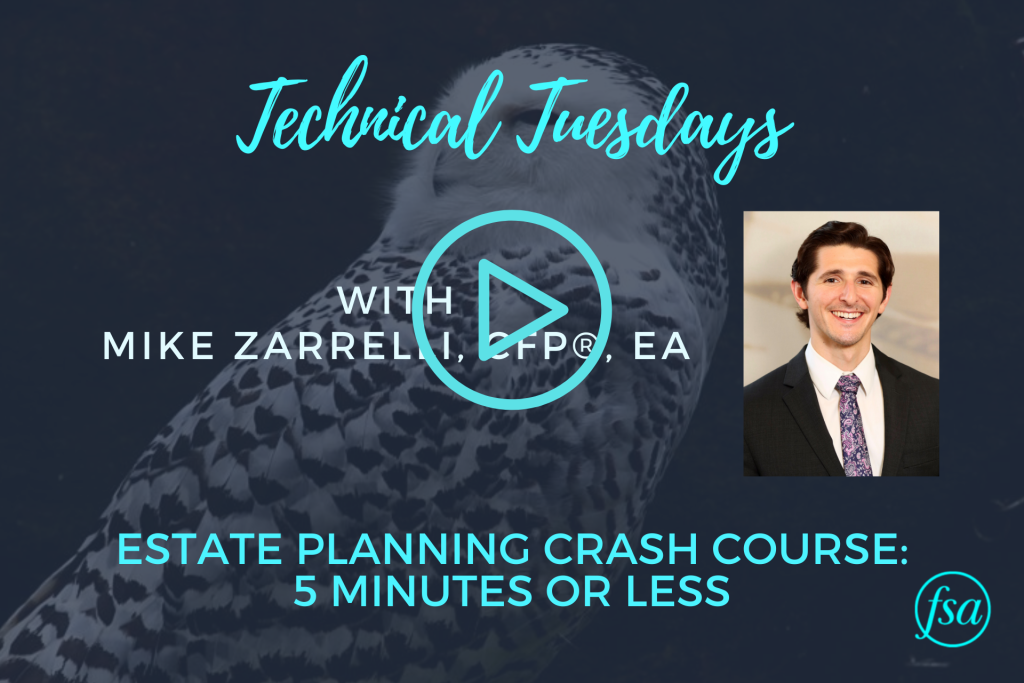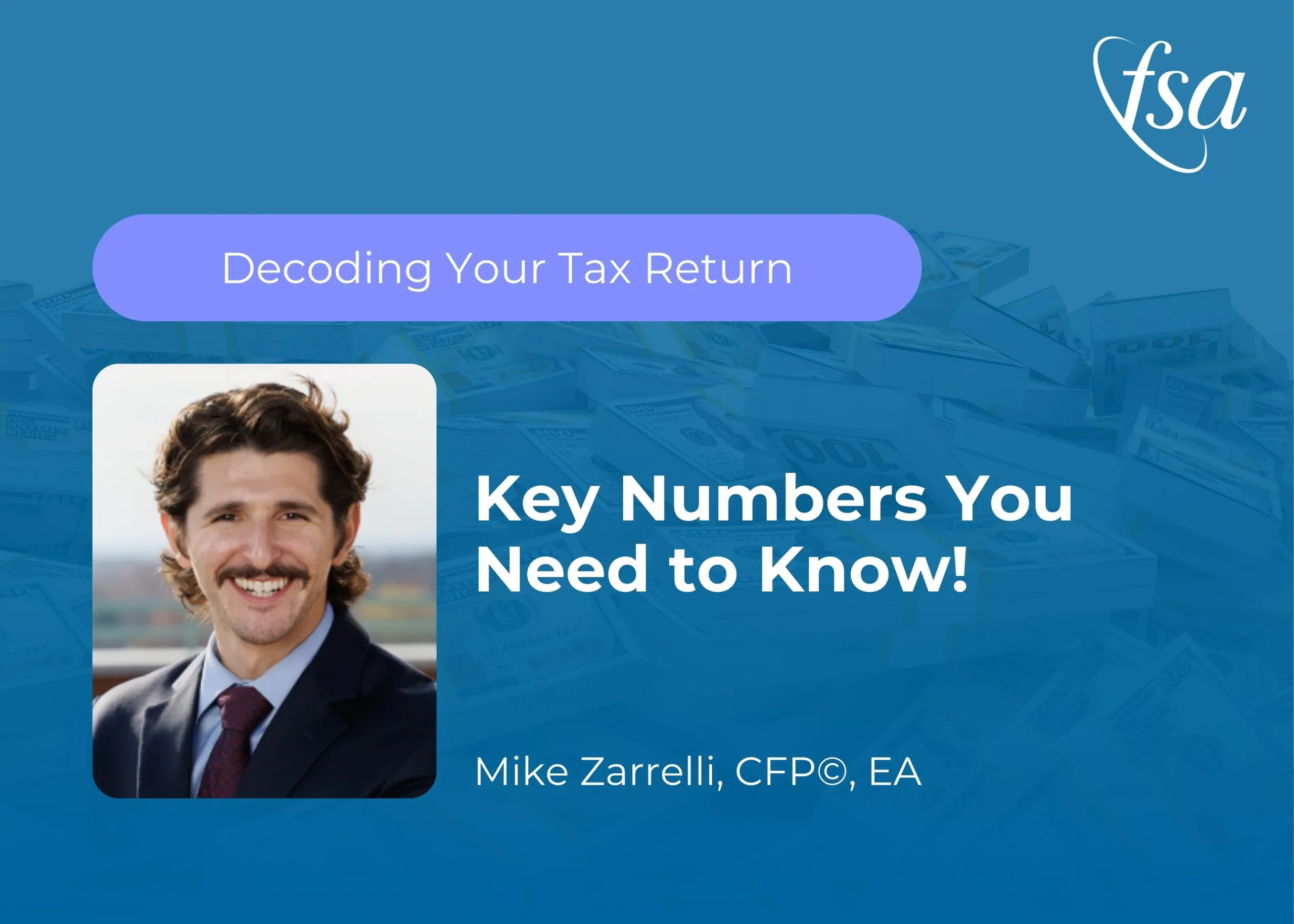Mike Zarrelli discusses the estate planning process in our latest video.
Estate Planning Crash Course Transcript
Hey, everyone. Welcome to this month’s financial planning video. Last month we wrote a blog about the estate planning package in five minutes. We’re going to try to do the same, replicate that process, and do a video about the estate planning package in about five minutes. So without any time to spare, let’s jump right in.
First, I’ll share my screen and we’ll show this pretty neat graphic that Napkin Finance put together about the estate planning process. And what are we trying to accomplish here? The estate planning package, it helps define what will happen to your stuff after you die. How do we get this done? There’s five main documents that can be used to facilitate that transfer. And why is it important? Really, it creates a roadmap for a clean and concise transfer of your stuff. With that, let’s dive right in.
The first one is will, and you can see Picasso, Prince, and a few others have died without a will, which means they had to go through probate to determine where does their stuff actually end up. Pretty messy. Don’t want to die without a will. So, a will is a legal document that gives instructions to the courts, your executor, and your beneficiaries of how you want your assets to flow. So again, you get to name your executor, your personal representative. If you have a spouse, a lot of times it’s that spouse that’s your first choice for executor, and then you’ll choose a backup, of course, as well. You’ll tell where you want your assets that go through probate, where you want those to go. And on top of it, there’s special delegations like if you have minor children who’s going to take care of those children in the event you pass away. Even dogs too, cats, dogs. So if you’re a pawrent, it’s important for you as well.
Next up is going to be the trust. If probate is not your style, you don’t want your information to be public, you don’t want it to go through the courts, setting up a trust can be a nice way to sidestep it. Now, trusts come with various benefits that we’ll have to go through in another video, but it can create a very smooth transition of your assets as well as provide creditor protection,. and it’s not a public document. If you go through probate, that is a public hearing, and anybody can read up on it. A trust is the opposite.
Next up is going to be that power of attorney document. So what happens if you become incapacitated, you didn’t pass away, but you are unable to pay your bills, you got sick or whatever happened and you are not able to pay your bills. That’s where this person, this document, will step in. Similar to your executor, you get to name a financial power of attorney and they will be able to handle your, paying your bills, making financial decisions for you, your investments, really anything that involves your financial world, and that way things can still… your financial world can continue running, bills being paid, investments being made until you recover.
Similarly to the financial power of attorney, there is this medical directive, and the medical directive kind of has two parts to it. There is the living will, which talks about what procedures you want done, how you want to be handled if you become incapacitated, and what kind of procedures you would want done. Do you want CPR? Do you want to be DNR? All of those questions you’ll answer in the living will. Now, they don’t want to just give you… you don’t want just a document and there’s no person to interpret it. With that living will, a lot of times there will be a healthcare power of attorney or healthcare proxy, and similarly to the financial power of attorney, it’s a person that you label that gives them power of attorney to then make those healthcare decisions for you, so they can pair it up with that living will and they can make those healthcare decisions for you in that time of need.
Okay, so now we’ve got pretty much the estate planning package done. What are those last steps that you need to do to finalize the estate planning process? And it is over here, you got to update your accounts. So, for example, if you set up your beneficiaries in your will or your trust, you need to make sure your accounts are updated as well. For example, employer retirement plans or qualified retirement plans, those actually don’t go through the will or through the trust. A lot of times they just have beneficiaries labeled and that’s how custodians like Schwab will distribute the assets when you pass away. So definitely got to make sure that those beneficiaries get updated as you decide who those beneficiaries are.
Second is, if you do create a trust, that’s one part of the process. Now you’ve got the entity, but you need to fund that entity afterwards. So, for example, let’s say you have a brokerage account, a joint brokerage account, or investment account at Charles Schwab. Right now it’s in your name, your and your spouse’s name, and it is not in the trust. What would need to happen is you need to retitle the investment account into the name of the trust, so the Jones Family Trust, with the trustees being you and your spouse. That’s typically what we see. And a lot of times this will be a revocable trust, meaning you’re not giving up custody of those assets, it’s still your money, you can still make investment decisions, pull money out. It’s just got that trust structure so that way if you do pass away, the account will follow the trust instructions.
So estate planning can get pretty complex. It’s hard to talk about all of this in five minutes but wanted to keep it short today. If you have questions, feel free to reach out to us at [email protected] or call us at (301) 949-7300. Hope to see you in the next video. Thanks.
FSA’s current written Disclosure Brochure and Privacy Notice discussing our current advisory services and fees is available at www.fsawealthpartners.com/disclosures or by calling 301-949-7300.




